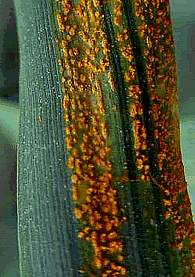Aerobiology Modeling of the Wheat Rust Pathogen Ug99 for Assessing Potential Pathways and Timing of Incursion

Photos: Amor Yahyaoui
Wheat rusts are an important group of airborne fungi that have had devastating impacts on North American agriculture in the past century. Currently, extensive monitoring and judicious deployment of a wide arsenal of management tools enable successful IPM for wheat and barley in our country. The emergence of a new Puccinia graminis tritici race complex (Ug99) in Africa threatens our country's biosecurity. This invasive pathogen has recently spread to Asia and appears to have overcome resistance provided by genes Sr24 and Sr31. As a result, more than three quarters of the U.S. wheat and barley crops are now at risk. It is paramount that we prepare a coordinated response for the incursion of this fungus into the U.S. as was done for soybean rust. For this response to be successful, we must understand the aerobiology of this invasive pathogen and the cause and effect relationships between pending changes in the climate system and its life history and geographic distribution as well as those of its hosts.
 Scott Isard and Joe Russo (ZedX Inc) in collaboration with ARS and Extension scientists are working to deliver two key components of the USDA effort to assess the worldwide spread of Ug99 and the risk of its incursion into North America: 1) Predictive modeling of aerial transport of wheat rust spores and disease development and 2) Development and operation of a web-based, near-real time platform for integration and synthesis of rust observations and model predictions. The geographic domain of the modeling component will center on east Africa and the Arabian Peninsula and include Africa, Middle East, Europe, and Southwest Asia, with expansion to other areas of the globe as observations of Ug99 warrant.
Scott Isard and Joe Russo (ZedX Inc) in collaboration with ARS and Extension scientists are working to deliver two key components of the USDA effort to assess the worldwide spread of Ug99 and the risk of its incursion into North America: 1) Predictive modeling of aerial transport of wheat rust spores and disease development and 2) Development and operation of a web-based, near-real time platform for integration and synthesis of rust observations and model predictions. The geographic domain of the modeling component will center on east Africa and the Arabian Peninsula and include Africa, Middle East, Europe, and Southwest Asia, with expansion to other areas of the globe as observations of Ug99 warrant.
Drs. Isard and Russo have received a grant from USDA CSREES Critical Issues Program to modify the Integrated Aerobiology Modeling Systems (IAMS), currently used to forecast soybean rust movement in North America, to address global scale questions including:
- What are the likely paths of aerial transport of the new wheat stem rust race complex to the U.S. from potential source regions in Latin America, northwestern Africa and eastern Asia?
- Is it feasible for wheat stem rust urediniospres to be transported from these regions to the continental U.S.?
- What is the transport time from these potential source regions to the U.S.?
- In which periods of the year are P. graminis f sp. tritici urediniospores with the new races most likely to arrive in the U.S.?
- Where in the U.S. is this pathogen most likely to enter?

